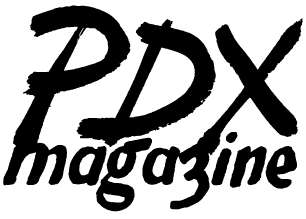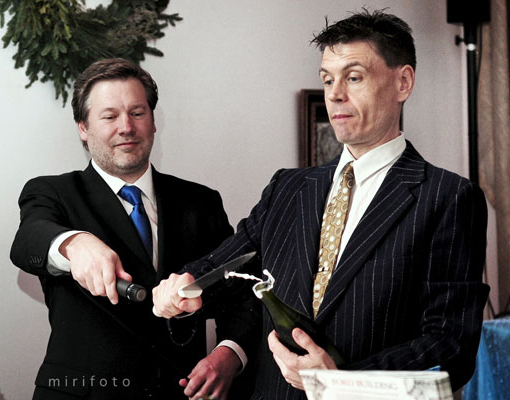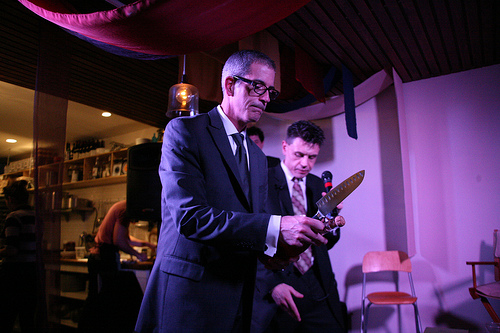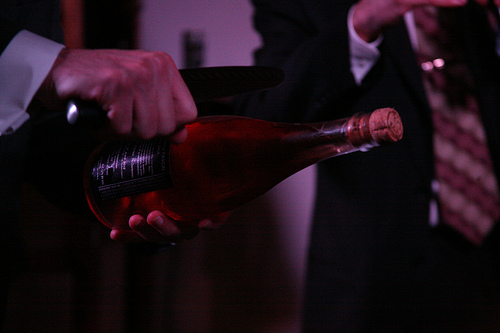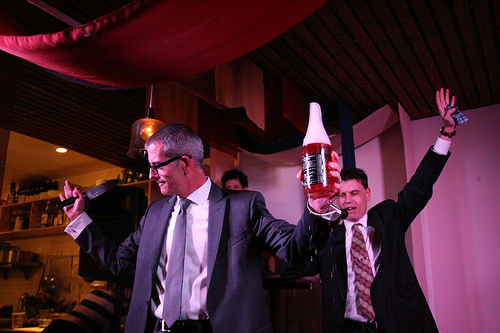Leo Daedalus, Host of The Late Now, sabres a bottle of sparkling wine at the PDX Magazine Issue #3 Launch Party at Lightbar on Dec 13, 2013. Also pictured Ross Blanchard, PDX Magazine Editor-in-chief. Photo by Miri Stebivka
By Ross Blanchard
When we open up a bottle of sparkling wine this holiday season, most of us don’t consider slashing off the top of it with a large blade. Most of us also are not on horseback, do not carry a sabre, and are not celebrating battlefield victories. These apparently were minor details on two separate occasions within the last month where I’ve witnessed the beheading of bottles of bubbly with chef’s knives.
“Sabrage” as the practice is called, may have started with Napoleon Bonaparte’s cavalry officers in the late 18th Century and is far from a practical way to get at a bottle’s contents, not to mention a wasteful practice. But this violent decapitation of the delicate, curved neck of a bottle is rather dramatic at a party, its precious contents, its life blood, gushing wastefully onto the floor.
While our inner-Hussar thinks only of the impetuous flair and danger of the swinging knife and the flying glass that brings cheers from party-goers, the next morning, staring at the empty bottle, its cork and rim still intact somewhere, perhaps a now-forgotten souvenir in the bottom of a purse or in a coat pocket, our throbbing noggins consider the neat cut on the bottle’s neck in wonderment.
Well, wonder no longer. It turns out there’s some interesting science behind sabrage. I turned to a physicist friend Lloyd Kaufman, who works as a materials scientist, to explain how sabrage works:
“Glass is by definition an amorphous solid, but a special kind of amorphous solid. The glass molecule (silica) is a tetrahedron crystal; however, when formed in a solid state, there is no long-range periodicity to the structure.
Even without long-range order, the glass can be made to behave as crystalline upon fracture. As with most solids, residual stresses are an intrinsic part of the material that are introduced in forming, even after annealing [heating and slow cooling of a material to toughen it]. These residual stresses are concentrated at forming lines or radii of curvature. In the case of a champagne bottle, you have two linear areas of high residual stress intersecting (the radius of curvature at the formed lip, and the fusion line of the bottle halves), providing a point of defect in the structure of the material. The point defect can be used to exploit the fracture—and the fracture will propagate in the direction of the applied force, along the line of concentrated stress (the forming lip), much like using a scribe to fracture glass. This phenomenon is further exploited by ensuring that the glass is sufficiently cold enough to embrittle the material.”
What he said.
Below: Bob Kingston, Resident Historian for the Portland Opera, demonstrates sabrage for The Late Now audience. Photo by Ryan Mooney.
